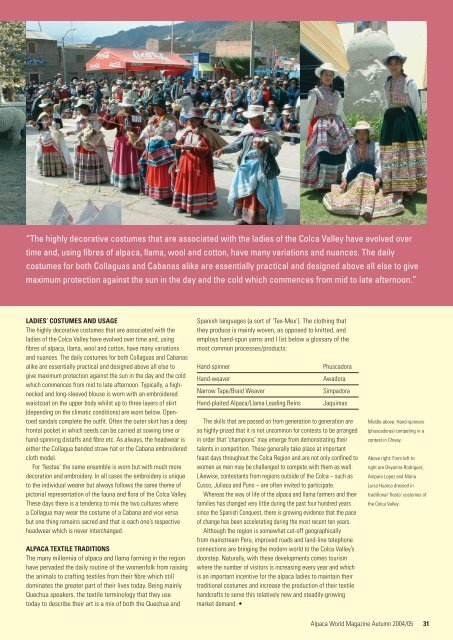You also want an ePaper? Increase the reach of your titles
YUMPU automatically turns print PDFs into web optimized ePapers that Google loves.
“The highly decorative costumes that are associated with the ladies of the Colca Valley have evolved over<br />
time and, using fi bres of alpaca, llama, wool and cotton, have many variations and nuances. The daily<br />
costumes for both Collaguas and Cabanas alike are essentially practical and designed above all else to give<br />
maximum protection against the sun in the day and the cold which commences from mid to late afternoon.”<br />
LADIES’ COSTUMES AND USAGE<br />
The highly decorative costumes that are associated with the<br />
ladies of the Colca Valley have evolved over time and, using<br />
fi bres of alpaca, llama, wool and cotton, have many variations<br />
and nuances. The daily costumes for both Collaguas and Cabanas<br />
alike are essentially practical and designed above all else to<br />
give maximum protection against the sun in the day and the cold<br />
which commences from mid to late afternoon. Typically, a highnecked<br />
and long-sleeved blouse is worn with an embroidered<br />
waistcoat on the upper body whilst up to three layers of skirt<br />
(depending on the climatic conditions) are worn below. Opentoed<br />
sandals complete the outfi t. Often the outer skirt has a deep<br />
frontal pocket in which seeds can be carried at sowing time or<br />
hand-spinning distaffs and fi bre etc. As always, the headwear is<br />
either the Collagua banded straw hat or the Cabana embroidered<br />
cloth model.<br />
For ‘fi estas’ the same ensemble is worn but with much more<br />
decoration and embroidery. In all cases the embroidery is unique<br />
to the individual wearer but always follows the same theme of<br />
pictorial representation of the fauna and fl ora of the Colca Valley.<br />
These days there is a tendency to mix the two cultures where<br />
a Collagua may wear the costume of a Cabana and vice versa<br />
but one thing remains sacred and that is each one’s respective<br />
headwear which is never interchanged.<br />
ALPACA TEXTILE TRADITIONS<br />
The many millennia of alpaca and llama farming in the region<br />
have pervaded the daily routine of the womenfolk from raising<br />
the animals to crafting textiles from their fi bre which still<br />
dominates the greater part of their lives today. Being mainly<br />
Quechua speakers, the textile terminology that they use<br />
today to describe their art is a mix of both the Quechua and<br />
Spanish languages (a sort of ‘Tex-Mex’). The clothing that<br />
they produce is mainly woven, as opposed to knitted, and<br />
employs hand-spun yarns and I list below a glossary of the<br />
most common processes/products:<br />
Hand-spinner Phuscadora<br />
Hand-weaver Awadora<br />
Narrow Tape/Braid Weaver Simpadora<br />
Hand-plaited Alpaca/Llama Leading Reins Jaquimas<br />
The skills that are passed on from generation to generation are<br />
so highly-prized that it is not uncommon for contests to be arranged<br />
in order that ‘champions’ may emerge from demonstrating their<br />
talents in competition. These generally take place at important<br />
feast days throughout the Colca Region and are not only confi ned to<br />
women as men may be challenged to compete with them as well.<br />
Likewise, contestants from regions outside of the Colca – such as<br />
Cusco, Juliaca and Puno – are often invited to participate.<br />
Whereas the way of life of the alpaca and llama farmers and their<br />
families has changed very little during the past four hundred years<br />
since the Spanish Conquest, there is growing evidence that the pace<br />
of change has been accelerating during the most recent ten years.<br />
Although the region is somewhat cut-off geographically<br />
from mainstream Peru, improved roads and land-line telephone<br />
connections are bringing the modern world to the Colca Valley’s<br />
doorstep. Naturally, with these developments comes tourism<br />
where the number of visitors is increasing every year and which<br />
is an important incentive for the alpaca ladies to maintain their<br />
traditional costumes and increase the production of their textile<br />
handcrafts to serve this relatively new and steadily-growing<br />
market demand. •<br />
Middle above: Hand-spinners<br />
(phuscadoras) competing in a<br />
contest in Chivay.<br />
Above right: From left to<br />
right are Deyanira Rodriguez,<br />
Amparo Lopez and Maria<br />
Luisa Huarca dressed in<br />
traditional ‘fi esta’ costumes of<br />
the Colca Valley.<br />
Alpaca World Magazine Autumn 2004/05 31







